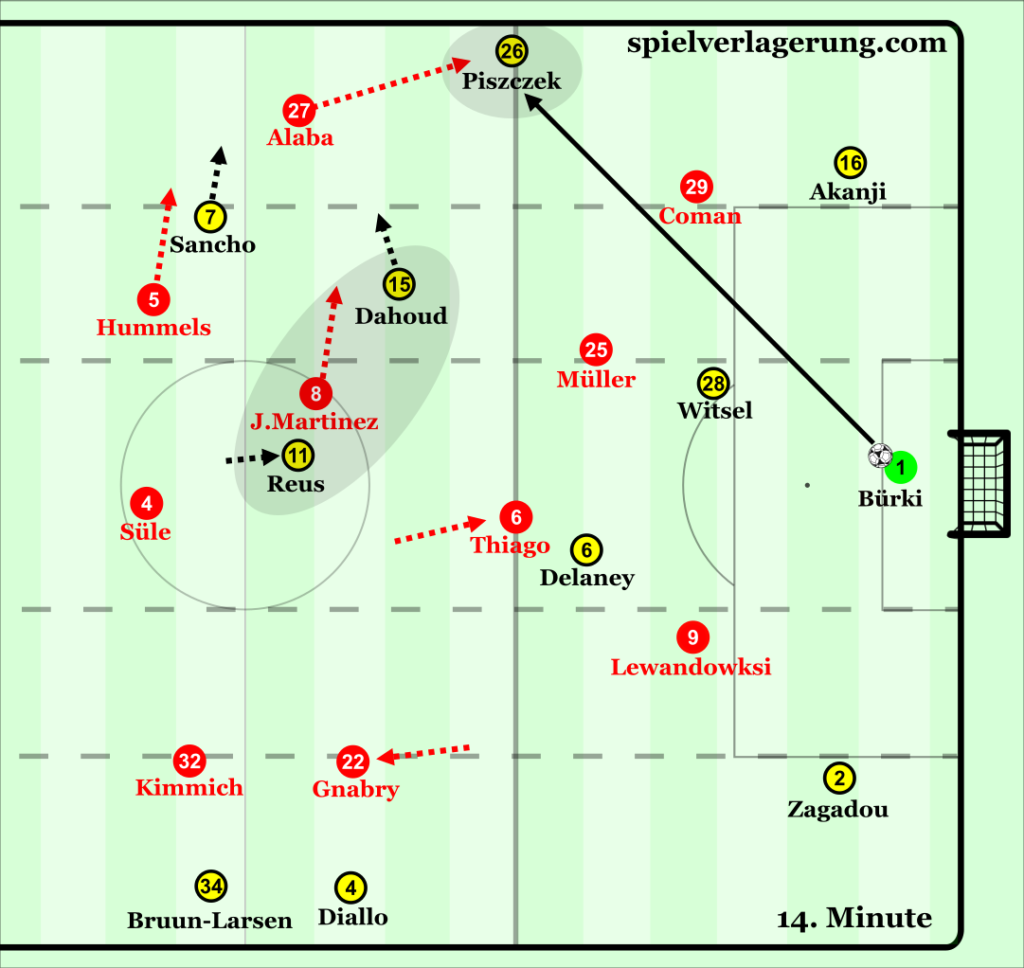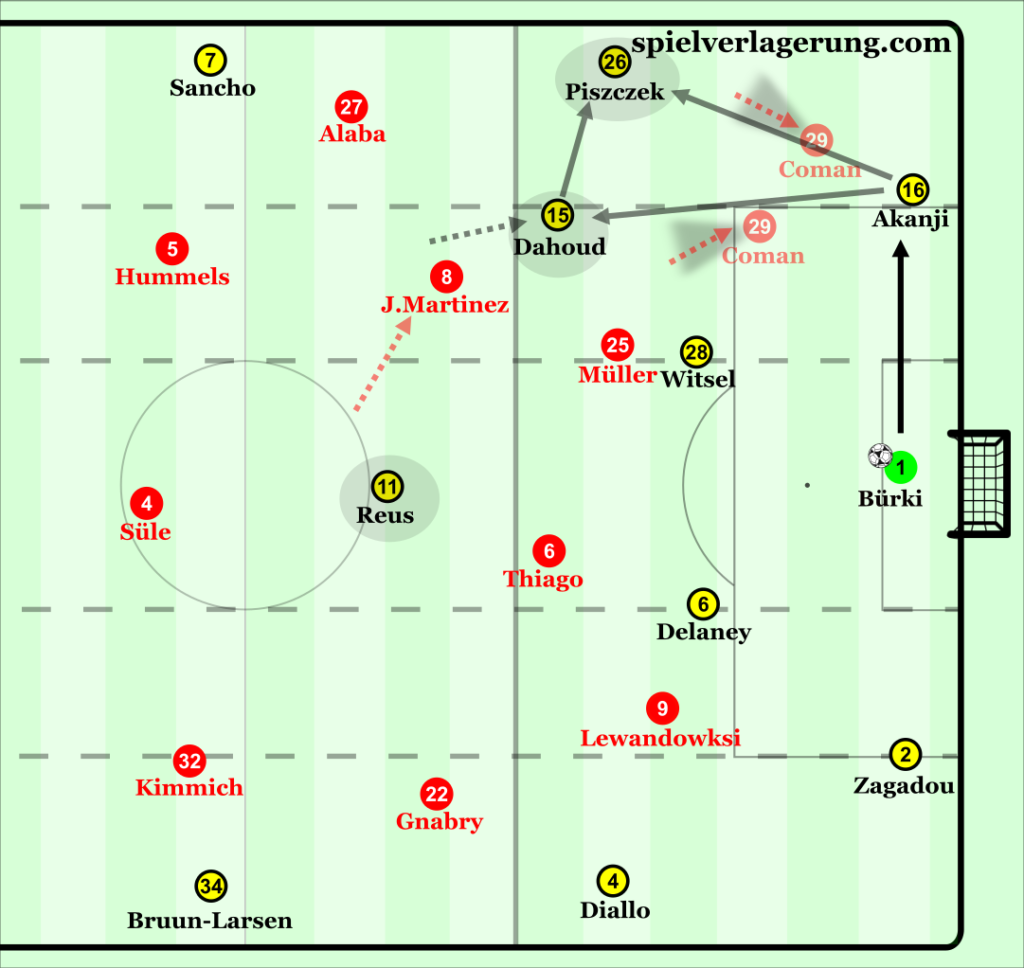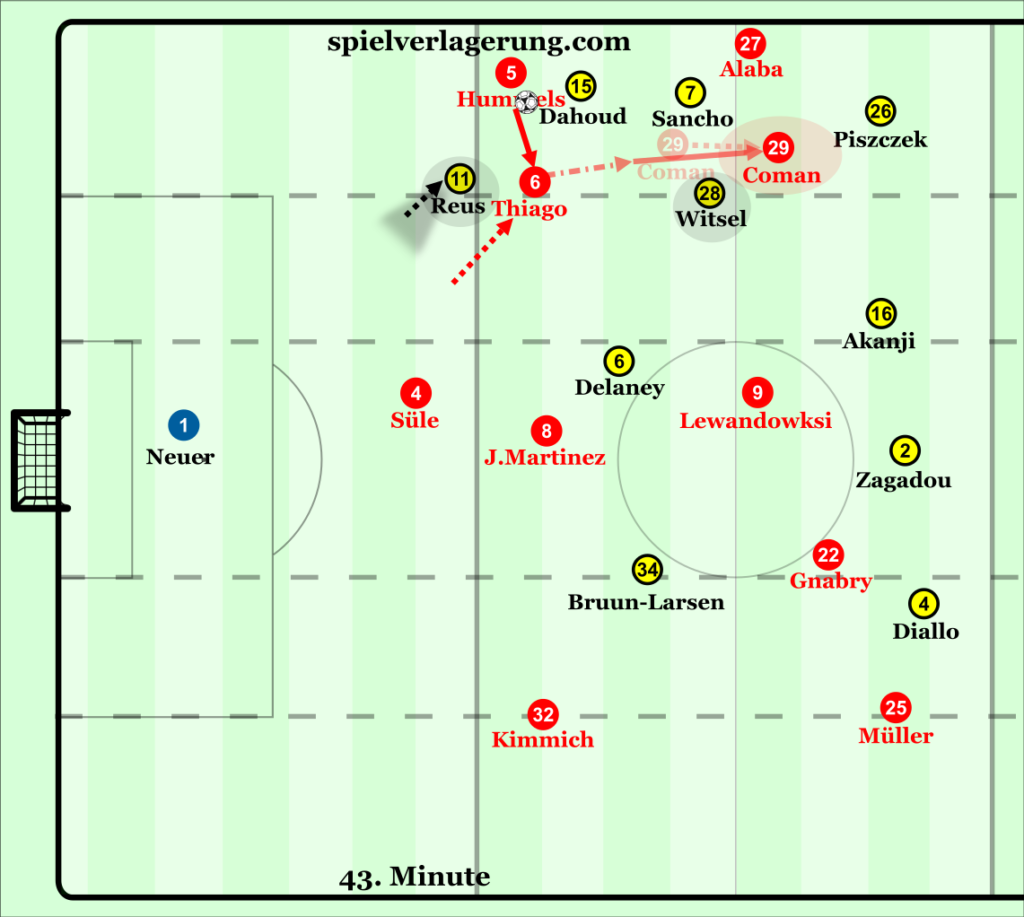Der Klassiker: clever Bayern strategy, 5-0 win over Dortmund
Bayern gains advantage in the title race after a surprisingly easy victory over Dortmund in the Allianz Arena, thanks to a dominant 4-0 1st half, where Bayern dominated due to their effective high pressing and in-possession strategy.
Line-ups
In overall the selected line-ups showed that both team’s objective was to stabilize their midfield. Bayern used a 4-2-3-1, with Müller in front of Thiago-Javi Martinez, who offered a great flexibility in both sides of the ball with dropping deeper to support. The 2 wingers, Gnabry and Coman dominantly stayed wide to stretch BvB’s last line and to open themselves up for possible 1v1s, plus this constant width also allowed Thiago to make diagonal switches towards the far-side.
To stabilize the centre Dortmund used a 4-1-4-1, with a Witsel-Delaney-Dahoud midfield trio, and Reus upfront, whose main task was to drop deeper in possession in order to create a midfield superiority , whilst Bruun Larsen and mostly Sancho could move inwards to exploit the vacated spaces.
Bayern pressing BvB build-up
Bayern immediately started the game very aggressively, pinning Dortmund to it’s own half, after constantly pressing up high their throw-ins, goal-kicks from where the away side couldn’t pass through, allowing Bayern to control the game’s basic dynamics and tempo – 75% possession in the first 15 minutes. Due to their pressing trap strategy -being narrow, leave the full-backs open-, they could force BvB to send long balls towards either full-backs, exploiting their physical advantages in the last line, plus cutting Dortmund’s connections towards the centre. They basically pressed in a 4-2-4-ish formation to counter Dortmund’s 4-2-2-2 build-up staggering – at first, only Witsel dropped deep to build in a 4-3-3, but since that was closed down easily, Delaney also started to drop deeper, forming the 4-2-2-2 shape.

Without further adjustments BvB struggled to build from the back, whilst their basic strategy would have been functional if Burki had initiated more passes towards the CBs – for that also the CBs should have positioned themselves better, offering even more depth towards the goal line. Another issue was the distances towards the FBs, who positioned themselves too high, making it easier for Bayern to press or trap them, since after a long ball it was easy for Alaba or Kimmich to shift out, due to the short distances. With positioning themselves deeper, they would have forced Bayern’s FBs to shift out even more -possibly creating a decision crisis too, to shift or not- after a long ball, plus would have offered a better connections for the CBs, in case they receive a pass from Burki. After a possible pass to either CBs depending on the 1st line’s covering angle several options would have been accessible to bypass the pressure.

Connection issues were also present in Dortmund’s circulation phase higher up the pitch, due to several reasons. The distances at the back weren’t optimal enough to effectively circulate the ball and move Bayern’s structure, making it easy for the home side to close down the valuable passing lanes and force the CBs to send aimless long balls towards the attackers. With having big distances in the last line, Akanji and Zagadou couldn’t pass to each other constantly and effectively, therefore Bayern’s 1st line easily isolated and forced them to drive forward and cut the accesses at the ball’s zone -sometimes even without having a pass between each other, not moving Bayern’s shape at all, allowing them to maintain compactness. A better distance between the CBs would have allowed to manipulate the 1st line to offer better passing connections as they drove forward. Plus they also couldn’t pass to the FBs, who positioned themselves too high in this phase as well. Even if they received, they couldn’t make forward 1st touches -only backwards to escape the press-, due to narrower passing angles and the shorter distances from the oppositional wingers/full-backs. Not to mention Witsel’s inaccurate positioning in front of them, whose passive horizontal movement allowed Müller-Lewandowski to easily cut the access towards him -with their cover shadow-, whilst pressuring the centre-backs.

Dortmund 1st & 2nd line issues, Bayern’s fluid passing game
As mentioned before, Müller’s flexibility was key in Bayern’s in-possession game. With constantly dropping to either halfspaces -depending on Thiago’s positioning-, he pinned a central-midfielder from Dortmund’s 2nd line, reducing their pressure and cover, frequently creating a 4-3-3 staggering. That allowed Bayern to comfortably pass the ball around BvB’s structure, moving them to eventually open up valuable passing lanes. This often opened up the possibility of direct switches between the halfspaces, to fasten up the circulation and to exploit the vacated spaces -mostly Süle or Thiago, driving forward on the ball-, as BvB’s ball-far CMs moved deeper in result of their shifting dynamics – plus they were forced to move deeper by Thiago & Müller’s positioning in between the lines. The direct switch also prevented Witsel to have enough time to adjust his positioning and shift to the ballnear halfspace, resulting open spaces in between the lines.

Apart from manipulating the 1st & 2nd line to reduce the press, Bayern’s positional fluidity was also key that allowed easier progressions and penetrations. For example, if Thiago stayed deeper in either side, both Lewandowski and Müller moved outwards to occupy the halfspaces in between the line, creating a similar staggering to Dortmund’s 4-2-2-2 in possession. That “central-square” attracted pressure from the central-midfielders, eventually opening up even more space for Thiago or the centre-backs in front of the 2nd line, from where they were effectively able to find the wingers with diagonal switches. This also pinned Witsel deep, preventing the 2nd line to make any possible forward shifts to press higher up, reducing cover upfront. Another fluid movement occurred at the flanks, a simple rotation between the CM-FB-W triangle: if Thiago received deeper, the full-backs -Alaba/Kimmich- moved higher up, and the wingers -Gnabry/Coman- moved inwards to exploit the space behind the outstepping BvB’ CMs -Delaney/Dahoud. Due to Sancho’s and Larsen’s inaccurate defending – tendency to move out wide too early towards the FBs, leaving the passing lane between them and the CM open-, Bayern could easily get behind BvB’s shape at the wide areas. It mostly happened on Sancho’s side –possible conscious strategy from Bayern to attack his side more-, who oriented himself too wide in defending, without effectively closing Alaba in depth, leaving him open in case he made a movement behind. This left Piszczek in a 1v2 situation, where both Coman was open to receive a pass in between the lines, and Alaba to receive a pass behind the last line. To exploit Sancho’s man-orientation, Alaba occasionally moved inside if Hummels’ had space in front, to pull Sancho inwards with himself, opening up the direct passing lane to Coman -progression through space, 1v1s-, and then made underlap runs to offer support and inside option for Coman.

If BvB’s central-midfielder moved up higher to press Bayern’s circulation phase, due to Kimmich’s and Alaba’s dropping movement to offer connection for the CBS, they were still able to circulate the ball, manipulating the 2nd line through the staggering to open up central options or to find the wingers out wide. These issues prevented Dortmund to effectively press higher even after being 2-0 down, resulting that they were able to approach Bayern’s box only 3 times during the first 35 minutes -although 1 of them was a huge chance ending with a shot on post in the 6th minute.

For the 2nd half Weigl came in for Zagadou, which immediately improved their passing at the back, as he used Piszczek more often to circulate or used his dribbling ability to escape the 1st line’s pressure effectively – switching sides then. Still Witsel’s positioning was not effective enough to offer support, therefore Favre switched to a 4-2-3-1, which helped Dortmund to create better and longer phases on the ball with Witsel-Delaney being deeper in front of the CBs -plus due to Bayern’s slightly decreasing pressure after leading 4-0. Apart from this change, the game’s dynamics remained the same, with BvB being incapable to build from goal-kicks and still having issues to press Bayern’s circulation higher up the pitch.
Bayern’s set-piece strategy – A situational analysis
Dortmund’s zonal-marking system was exploited in several cases, mostly with clever movements to exploit the short-post zone at corners, resulting 2 goals:
Conclusion
Due to their complete domination mainly in the first 20 minutes, Bayern could keep Dortmund off-balance in all phases of the game. Kovac definitely outsmarted Favre with his basic gameplan, with the latter being unable to effectively react in the 1st half, which decided the game. This victory put Bayern into the 1st position to lead by 1 point, and after a slow start Kovac might save his job if they retain the Bundesliga title.



Keine Kommentare vorhanden Alle anzeigen